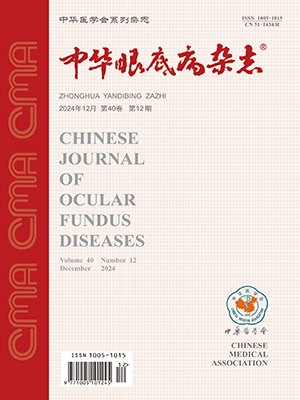| 1. |
Wong RL, Lai TY. Polypoidal choroidal vasculopathy: an update on therapeutic approaches[J]. J Ophthalmic Vis Res, 2013, 8(4):359-371.
|
| 2. |
Hata M, Tsujikawa A, Miyake M, et al. Two-year visual outcome of polypoidal choroidal vasculopathy treated with photodynamic therapy combined with intravitreal injections of ranibizumab[J]. Graefe's Arch Clin Exp Ophthalmol, 2015, 253(2): 189-197. DOI: 10.1007/s00417-014-2675-6.
|
| 3. |
Ho M, Lo EC, Young AL, et al. Outcome of polypoidal choroidal vasculopathy at 1 year by combined therapy of photodynamic therapy with ranibizumab and predictive factors governing the outcome[J]. Eye (Lond), 2014, 28(12): 1469-1476. DOI: 10.1038/eye.2014.222.
|
| 4. |
Inoue M, Arakawa A, Yamane S, et al. Long-term outcome of intravitreal ranibizumab treatment, compared with photodynamic therapy, in patients with polypoidal choroidal vasculopathy[J]. Eye (Lond), 2013, 27(9): 1013-1020. DOI: 10.1038/eye.2013.179.
|
| 5. |
Sakurada Y, Iijima H. Two-year results of photodynamic therapy with or without intravitreal ranibizumab for polypoidal choroidal vasculopathy[J]. J Ocul Pharmacol Ther, 2013, 29(9):832-836. DOI: 10.1089/jop.2013.0044.
|
| 6. |
Saito M, Iida T, Kano M, et al. Two-year results of intravitreal ranibizumab for polypoidal choroidal vasculopathy with recurrent or residual exudation[J]. Eye (Lond), 2013, 27(8): 931-939.DOI: 10.1038/eye.2013.114.
|
| 7. |
Sato T, Kishi S, Matsumoto H, et al. Comparisons of outcomes with different intervals between adjunctive ranibizumab and photodynamic therapy for polypoidal choroidal vasculopathy[J]. Am J Ophthalmol, 2013, 156(1): 95-105. DOI: 10.1016/j.ajo.2013.02.006.
|
| 8. |
Yoshida Y, Kohno T, Yamamoto M, et al. Two-year results of reduced-fluence photodynamic therapy combined with intravitreal ranibizumab for typical age-related macular degeneration and polypoidal choroidal vasculopathy[J]. Jpn J Ophthalmol, 2013, 57(3): 283-293. DOI: 10.1007/s10384-013-0234-z.
|
| 9. |
Wang W, He M, Zhang X. Combined intravitreal anti-VEGF and photodynamic therapy versus photodynamic monotherapy for polypoidal choroidal vasculopathy: a systematic review and meta-analysis of comparative studies. PLoS One, 2014, 9(10): 110667. http://dx.plos.org/10.1371/journal.pone.0110667. DOI: 10.1371/journal.pone.0110667.
|
| 10. |
Bessho H, Honda S, Imai H, et al. Natural course and funduscopic findings of polypoidal choroidal vasculopathy in a Japanese population over 1 year of follow-up[J]. Retina, 2011, 31(8): 1598-1602. DOI: 10.1097/IAE.0b013e31820d3f28.
|
| 11. |
Lai TY, Chan WM. An update in laser and pharmaceutical treatment for polypoidal choroidal vasculopathy[J]. Asia Pac J Ophthalmol (Phila), 2012, 1(2): 97-104. DOI: 10.1097/APO.0b013e31823e5a95.
|
| 12. |
Matsuoka M, Ogata N, Otsuji T, et al. Expression of pigment epithelium derived factor and vascular endothelial growth factor in choroidal neovascular membranes and polypoidal choroidal vasculopathy[J]. Br J Ophthalmol, 2004, 88(6): 809-815.
|
| 13. |
Koh A, Lee WK, Chen LJ, et al. EVEREST study: efficacy and safety of verteporfin photodynamic therapy in combination with ranibizumab or alone versus ranibizumab monotherapy in patients with symptomatic macular polypoidal choroidal vasculopathy[J]. Retina, 2012, 32(8): 1453-1464. DOI: 10.1097/IAE.0b013e31824f91e8.
|
| 14. |
王静, 王尔茜, 陈有信, 等.光动力疗法与玻璃体腔注射抗血管内皮生长因子制剂治疗息肉样脉络膜血管病变的系统评价[J].中华眼科杂志, 2013, 49(12):1094-1103. DOI:10.3760/cma.j.issn.0412-4081.2013.12.008.Wang J, Wang EQ, Chen YX, et al. Efficacy evaluation of photodynamic therapy and intravitreal anti-VEGF injection for polypoidal choroidal vasculopathy: systematic review[J]. Chin J Ophthalmol, 2013, 49(12): 1094-1103. DOI:10.3760/cma.j.issn.0412-4081.2013.12.008.
|
| 15. |
Saito M, Iida T, Kano M, et al. Two-year results of combined intravitreal ranibizumab and photodynamic therapy for polypoidal choroidal vasculopathy[J]. Graefe's Arch Clin Exp Ophthalmol, 2013, 251(9): 2099-2110. DOI: 10.1007/s00417-013-2323-6.
|
| 16. |
Gomi F, Sawa M, Wakabayashi T, et al. Efficacy of intravitreal bevacizumab combined with photodynamic therapy for polypoidal choroidal vasculopathy[J]. Am J Ophthalmol, 2010, 150(1):48-54.DOI: 10.1016/j.ajo.2010.02.008.
|




